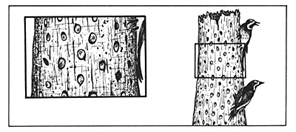Hoarding Food |
||
|---|---|---|
ink drawing by Shahid Naeem |
Nutcrackers and jays tend to store acorns, nuts, seeds, pine cones, and other items in the soil or under loose litter, as well as in elevated niches and cracks. A Clark's Nutcracker may store more than 30,000 pinyon pine seeds during a single season, placing them in caches with 4-to-5 seeds each. The trees are not always passive victims in this game, however. For instance, pinyon and other pines are coevolving with Clark's Nutcrackers and Pinyon jays, with the trees affecting the birds' evolution, and vice versa. The pines appear to have evolved cone and seed structures and fruiting times that increase the chance for their seeds to be buried (planted) by the birds. For example, whitebark pines have been shown to be | |
|
dependent on Clark's Nutcrackers for their
reproduction. Other animals harvest and feed on their seeds,
but only the nutcrackers cache them in places favorable to
the growth of the tree and at an appropriate depth for
seedling establishment. The nutcrackers and jays, in turn, have evolved to exploit this resource. Clark's Nutcracker has evolved both a long, sharpbill for use in prying the pine seeds from their cones, and a special pouch under the tongue for carrying them. One individual was found with 38 seeds, weighing a total of more than an ounce, in its pouch. A powerful flier, the nutcracker can carry its burden of seeds a long distance. It can start breeding as early as February by exploiting its hoarded seeds. North American jays have not proceeded quite as far down that evolutionary path as the nutcracker. Pinyon jays store seeds in an expandable esophagus, but are unable to transport as large a load as the nutcracker. Steller's jays have a less specialized bill, and an esophagus of smaller capacity, and Scrub jays (which are the least dependent of all on stored food in the winter) can carry only one seed at a time. Both birds and pines benefit from the relationship. The birds get fed and the trees get millions of their seeds buried, not just in the immediate vicinity, but in adjacent areas for miles around. Movement by the birds promotes rapid colonization by the pines of new areas made suitable for them as a result of climatic change. In contrast to these mutually beneficial relationships, Acorn Woodpeckers seem to be predators on oaks, because generally they do not place the acorns in sites suitable for germination. Thus the oaks gain little, if any, benefit from the relationship. Some birds, especially parids (titmice, chickadees), some raptors, owls, shrikes, and (occasionally) woodpeckers, store animal prey, but this seldom extends beyond short-term storage of a few days, because such prey soon decay. Exceptions may be the victims of northern owls and parids, for fall-stored mammals and insects may be preserved by cold and used over a longer period. This is indicated by the recent discovery that Great Horned, Boreal, and Saw-whet Owls thaw frozen prey by incubating them as they would eggs! All the thoroughly studied, long-term-storing birds use conifer seeds, acorns, and other nuts that are energy rich and yet have a hard, impervious coat that retards spoilage. Some acorns apparently can be stored for up to a year or more. Careful observations are needed of nuthatch hoarding behavior, about which little is know. Also desirable would be information on the elapsed time before hoards are recovered. Marking of the stores and repeated observations should help to solve the question of their "shelf life" and their relative importance to the birds. |
||
| SEE:
Finding Hidden Caches;
Coevolution;
Bills. Copyright ® 1988 by Paul R. Ehrlich, David S. Dobkin, and Darryl Wheye. |
||
